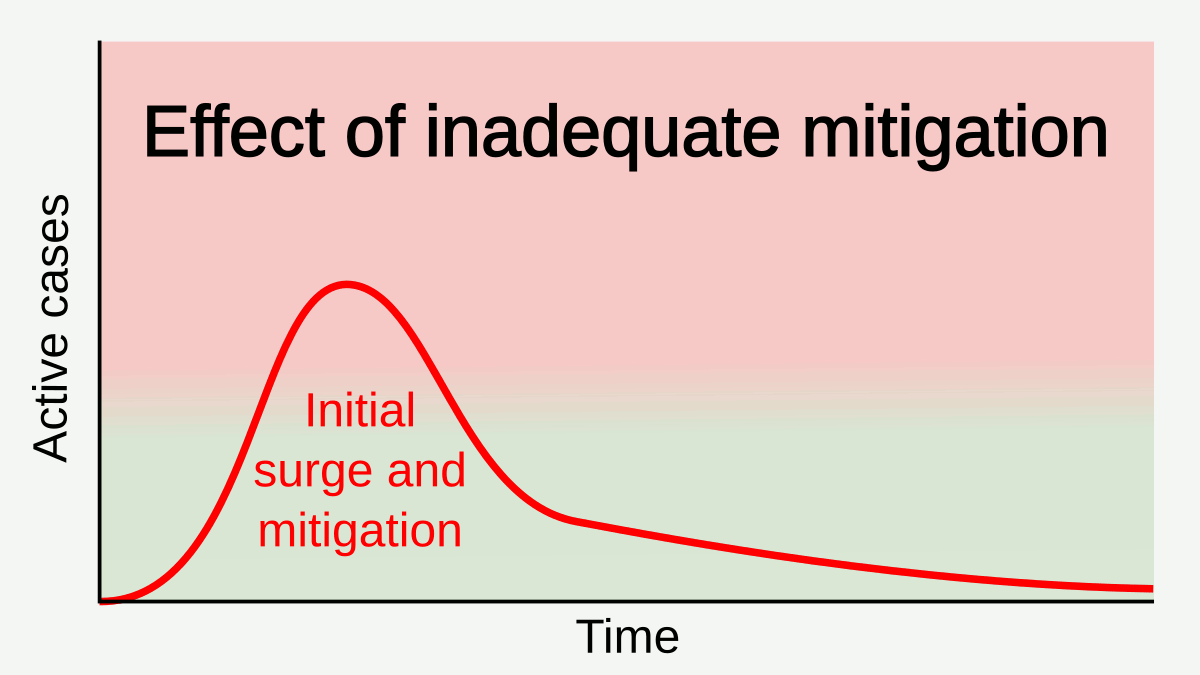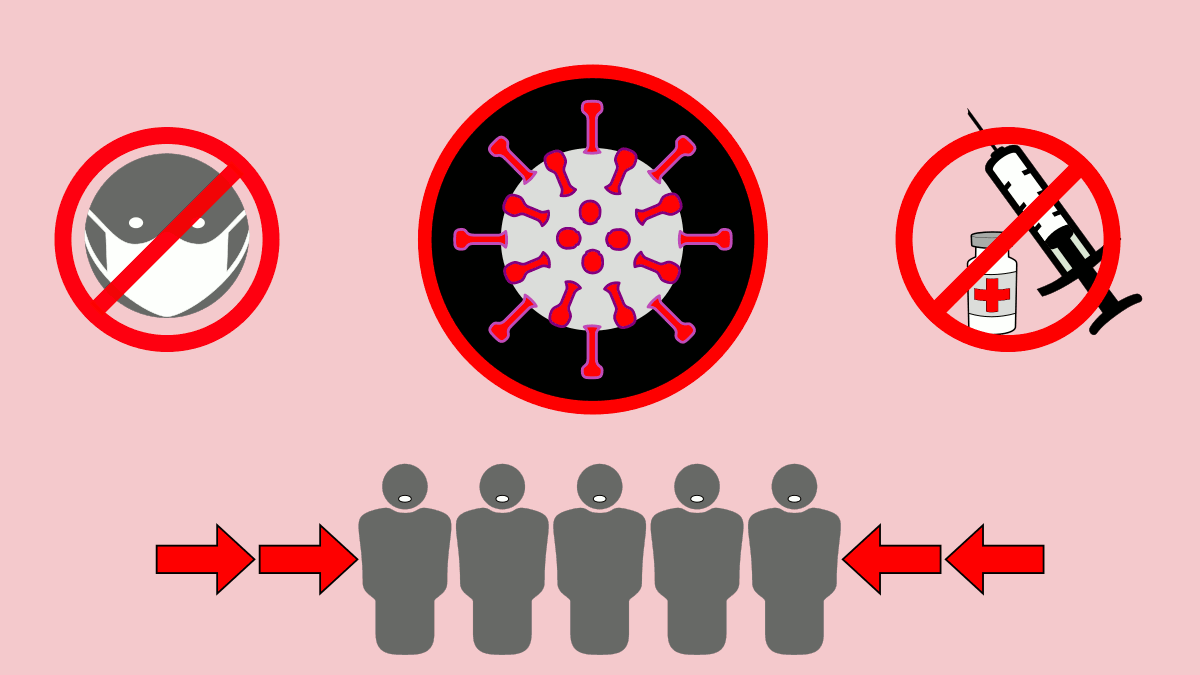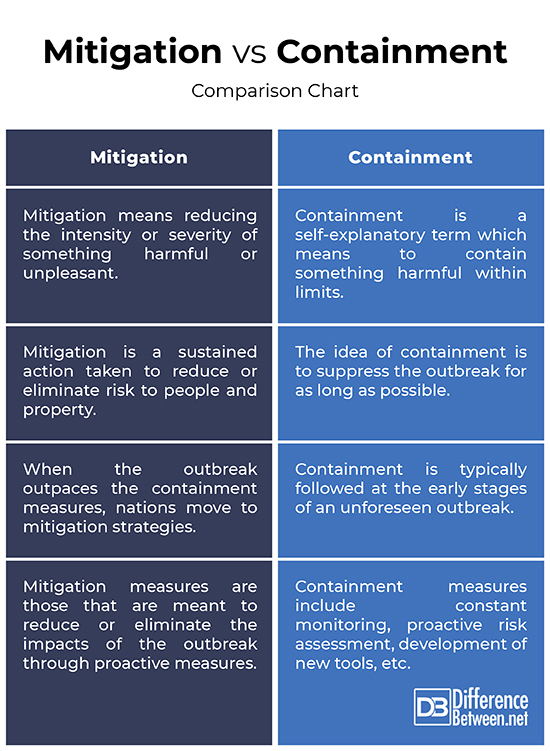Difference Between Mitigation and Containment
The current COVID-19 crisis has brought even the most powerful nations to its knees, triggering a worldwide panic and forcing the nations to take bold policy measures. The system which is hugely impacted by this pandemic is the health care systems. So, in order to reduce the spread of the novel virus and to lessen the burden on healthcare system, some preventive or you can say mitigation measures have been taken, such as social distancing, closures of schools and other educational institutions, travel restrictions, and so on. So, mitigation, in epidemiological terms, is to put certain preventive measures in place to slow down the spread of the virus. Containment is a self-explanatory term which means to contain something harmful within limits, or in the wake of the current pandemic, is relative to the term lockdown to mitigate the further spread of the virus.

What is Mitigation?
Mitigation means reducing the intensity or severity of something harmful or unpleasant, such as a disease, pain, or more extreme circumstances, such as the ongoing COVID-19 crisis. It is the act of reducing the loss as a direct result of an undesirable event. It is a sustained action or a set of preventive measures taken to reduce or eliminate risk to people and property. Mitigation is one of the four emergency management strategies as described in the National Response Framework, the others being preparedness, response, and recovery. The measures taken about mitigation determine the safety of an affected region in the face of unforeseen events. To put in the context of the current COVID-19 pandemic, various mitigation measures have been taken to mitigate the spread of the infectious virus, such as travel restrictions, social distancing norms, ban on mass gathering, wearing of masks, and so on.

What is Containment?
Containment was originally developed as an emergency management strategy for nuclear industries, but is now used across various industries, such as biological processing industries, sterile products manufacturing. However, these are specialty areas which require a certain approach or specialized design features. In epidemiological terms, containment is an effective responsive measure followed by a sequence of interventions usually put in place at the early stages of transmission of an infectious disease. This is followed by the control and mitigation measures in the wake of rising community transmissions or the rapid spread of the disease. New diseases, such as the newly discovered Novel Coronavirus disease, or COVID-19, require new interventions and new evasive measures and because they appear rarely and spread rapidly, they require constant monitoring and proactive risk assessment. So, a key factor in the rapid implementation of containment measures is early detection.
Difference between Mitigation and Containment
Meaning
– Both mitigation and containment are effective emergency management strategies meant to reduce the loss from an undesirable event. Containment is a self-explanatory term which means to contain something harmful within limits, whereas mitigation is a sustained action or a set of preventive measures taken to reduce or eliminate risk to people and property in the wake of an unforeseen event.
Epidemiology
– In epidemiological terms, containment is an effective responsive strategy followed by a sequence of measures usually put in place at the early stages of transmission of an infectious disease. Mitigation, on the other hand, is to put certain preventive measures in place to slow down the spread of the virus. Early detection is the key to reducing the spread of any infectious disease or virus. For example, the current COVID-19 pandemic has forced the nations to take effective mitigation measures to halt and contain the rapid escalation of the novel coronavirus.
Objective
– The objective of any mitigation strategy is to follow certain guidelines using a combination of a few mitigation measures or strategies. The first goal is to change the nature of the threat, which includes efforts to contain the spread, and second, efforts would require minimizing or containing the community vulnerability to damage. Finally, mitigation measures may be put in place to reduce the exposure of the threat, which may include putting regulatory restrictions on affected areas. The objective of containment strategy is to buy some time to delay the spread of the threat. The idea of containment is to suppress the outbreak for as long as possible.
Measures
– A key factor in the rapid implementation of containment measures is early detection and for this, it requires constant monitoring and proactive risk assessment. Because containment is typically followed at the early stages of an unforeseen outbreak, containment are hot harsh measures but coping mechanisms to delay the spread of the outbreak. Mitigation, on the other hand, usually comes after containment and when a disaster or a disease outpaces the containment measures, nations move to mitigation strategies. The measures taken about mitigation determine the safety of an affected region in the face of unforeseen events.
Mitigation vs. Containment: Comparison Chart

Summary of Mitigation vs. Containment
While all stages of emergency management are very crucial, mitigation and containment play a particularly fundamental role in pre- and post-disaster emergencies. Ironically, mitigation is the least visible aspect of an effective disaster management strategy, despite it being the most important strategy to protect communities from undesirable events or disasters. Containment is a comprehensive disaster response strategy which is just as vital as mitigation but containment should begin the moment the first case is detected regardless of the nature of the outbreak, which is mostly likely to be unknown.
- Difference Between FTP and SFTP - April 16, 2024
- Difference Between El Nino and La Nina - April 13, 2024
- Difference Between an Arbitrator and a Mediator - April 11, 2024
Search DifferenceBetween.net :
 Email This Post
: If you like this article or our site. Please spread the word. Share it with your friends/family.
Email This Post
: If you like this article or our site. Please spread the word. Share it with your friends/family.
1 Comment
Leave a Response
References :
[0]Lemon, Stanley M. et al. Ethical and Legal Considerations in Mitigating Pandemic Disease: Workshop Summary. Washington, D.C., United States: National Academies Press, 2007. Print
[1]World Health Organization. Managing Epidemics: Key Facts about Major Deadly Diseases. Geneva, Switzerland: WHO, 2018. Print
[2]Jerolleman, Alessandra and John J. Kiefer. Natural Hazard Mitigation. Florida, United States: CRC Press, 2012. Print
[3]Gaddis, John Lewis. Strategies of Containment: A Critical Appraisal of American National Security Policy during the Cold War. Oxford, England: Oxford University Press, 2005. Print
[4]Image credit: https://upload.wikimedia.org/wikipedia/commons/5/54/20200409_Pandemic_resurgence_-_effect_of_inadequate_mitigation.gif
[5]Image credit: https://commons.wikimedia.org/wiki/File:20200615_Effect_of_pandemic_containment_measures_-_International.gif


This is very nice content..